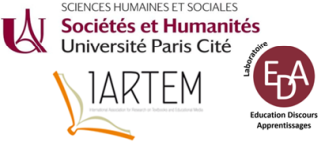Research problem and research questions
The paper reports on part of a broader PhD research project on the selection and use of printed and digital learning materials in the teachers' preparation and teaching process itself at the lower secondary school in English and Biology. In the framework of research on materials selection and use, the investigation focuses in particular on the modifications that teachers make (or do not make) with learning materials and the purposes of use.
The research responds to previous studies demonstrating the growing importance of digital materials, especially after the COVID-19 pandemic. Digital technologies provide new affordances (Mochizuki & Bruillard, 2019) and also introduce new challenges, including issues of efficiency, fairness in access, and adaptation of teaching methods (Haleem et al., 2022). Teachers play a very important and active role in using both types of learning materials, considering various factors such as their own pedagogical goals and the needs of students (Li & Harfitt, 2018). Teachers can modify the learning materials in different ways to better achieve the objectives. According to studies (e.g. Chen et al., 2020), teachers often add to teaching materials, modify them less often, and remove the original content rarely.
The study underscores the importance of teacher agency in selecting, using, and modifying learning materials to cater to diverse learning needs and enhance educational outcomes. The following research questions have guided the investigation:
1) How do the lower secondary teachers of Biology and English language choose printed and digital learning materials, where do they look for them, and where do they get information about them?
2) How do the lower secondary teachers of Biology and English language use and modify printed and digital learning materials?
3) For what purposes do the lower secondary teachers of Biology and English language select the printed and digital learning materials, and for what purposes do they subsequently use them?
Methodology
The research employs a mixed-methods design, including surveys, in-depth interviews, field observations, and content analysis. This approach ensures a deeper understanding of how teachers incorporate various types of learning materials into their teaching while also supporting the greater validity and reliability of the research.
The paper focuses on presenting the results in relation to research question 3, i.e. the purposes of selecting and using the materials. In-depth semi-structured interviews were performed with 5 English language teachers and 5 Biology teachers, and structured observations of two lessons for each were made. Participants were selected using the maximum variation sampling method. The interviews were recorded and transcribed verbatim. Data analysis was then conducted through open coding, and constant comparison analysis was applied. The programme ATLAS.ti, version 7, was used. The resulting findings were compared with the lesson observations.
Preliminary results
The research provides insights into the evolving role of learning materials' use in contemporary hybrid teaching and learning environments. It highlights the dynamic interplay between printed and digital resources in lower secondary education, specifically in the subjects of Biology and English. Preliminary results regarding the materials' usage indicate that printed textbooks with workbooks still play a vital role in English language and Biology classes. However, the purposes of their use differed not only between the two subjects but also depending on the learning materials' styles of use by individual teachers. Nevertheless, the role of the textbook, whether print or digital, seems to be changing from being a repository of information to becoming more of a coordinating and integrating factor between all other resources. Digital learning materials were selected and used in lessons mainly as a means of motivating students, visualizing content and structuring it.
The study underscores the importance of teacher agency in selecting, using, and modifying learning materials to cater to diverse learning needs and enhance educational outcomes.
References
Chen, B., Wei, B., & Wang, X. (2020). Examining the factors that influence high school chemistry teachers' use of curriculum materials: From the teachers' perspective. Journal of Baltic Science Education, 19(6), 893–907.
Haleem, A., Javaid, M., Asim Qadri, M, Suman, R. (2022). Understanding the role of digital technologies in education: A review. Sustainable Operations and Computers, 3, 275–285.
Li, Z., & Harfitt, G. (2018). Understanding language teachers' enactment of content through the use of centralized curriculum materials. Asia-Pacific Journal of Teacher Education, 46(5), 461–477. DOI: 10.1080/1359866X.2017.1351918.
Mochizuki, Y., & Bruillard, E. (Eds.) (2019). Rethinking pedagogy: Exploring the potential of digital technology in achieving quality education. UNESCO, MGIEP.
- Poster

 PDF version
PDF version

